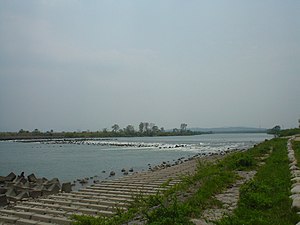Agano River
| Agano River | |
|---|---|

Agano River, 5/5/2007
|
|
| Native name | 阿賀野川 |
| Country | Japan |
| Basin features | |
| Main source |
Mount Arakai, border of Fukushima Prefecture and 1,581 m (5,187 ft) |
| River mouth |
Sea of Japan, Niigata Prefecture 0 m (0 ft) 37°57′48″N 139°07′46″E / 37.963224°N 139.129556°ECoordinates: 37°57′48″N 139°07′46″E / 37.963224°N 139.129556°E |
| Basin size | 7,710 km2 (2,980 sq mi) |
| Physical characteristics | |
| Length | 210 km (130 mi) |
| Discharge |
|
The Agano River (阿賀野川 Agano-gawa?) is a river in the Hokuriku region of Honshu, Japan. It is also called the Aga River or the Ōkawa River in Fukushima.
The source of the river is Mount Arakai on the border of Fukushima and . It flows to the north and meets the Nippashi River from Lake Inawashiro and the Tadami River in the Aizu Basin, and then turns to the west and falls into the Sea of Japan. The Agano River flows for 210 kilometers. It has a watershed area of 7,710 square kilometers.
In 1964-1965, a chemical factory at Kanose village in Niigata Prefecture released methylmercury into the river and caused Niigata Minamata disease.
There are several hydroelectric power plants on the Agano River:
...
Wikipedia
